Everything About Skin Tags
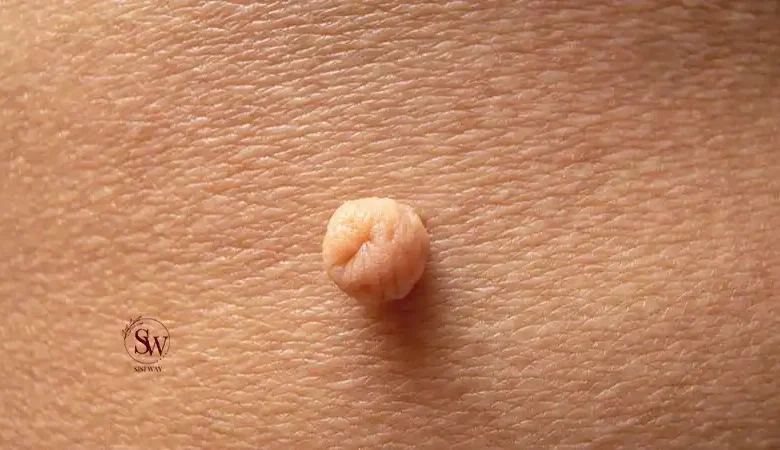
Skin tags, those tiny, benign growths that often pop up on various parts of our bodies, can be a source of curiosity, concern, and even frustration for many individuals. In this in-depth exploration, we aim to shed light on everything related to skin tags – from their causes and characteristics to potential treatment options and preventive measures. Let’s embark on a journey to demystify these seemingly innocuous yet perplexing skin developments.
What Are Skin Tags?
Skin tags, scientifically known as acrochordons, are small, soft, benign growths that protrude from the skin. These often appear in areas where skin rubs against skin or clothing, such as the neck, underarms, groin, and eyelids. Though harmless, their presence can be bothersome for some individuals, leading to a desire for understanding and potential removal.
Characteristics of Skin Tags
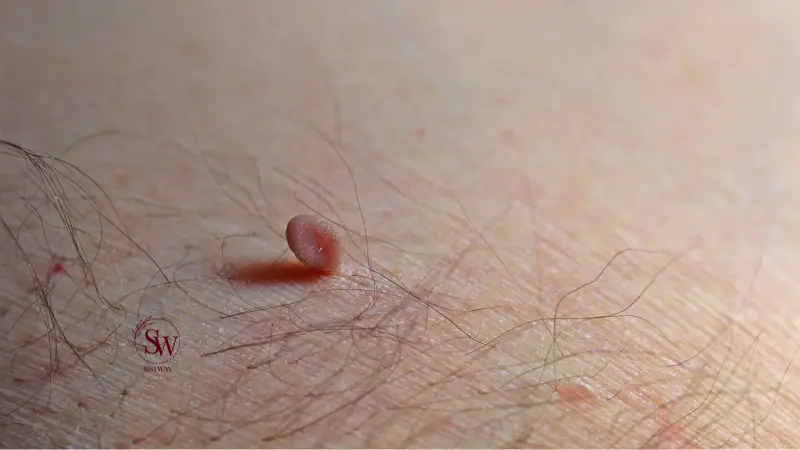
- Appearance: Skin tags typically present as small, flesh-colored, or slightly darker growths attached to the skin by a narrow stalk.
- Size: While skin tags can vary in size, they are generally small, ranging from a few millimeters to a centimeter.
- Texture: These growths are soft and pliable, often described as having a smooth or slightly wrinkled texture.
What Causes Skin Tags?
The emergence of skin tags remains a fascinating puzzle for researchers and medical professionals alike. While the exact cause of skin tags is not definitively established, several contributing factors have been identified, shedding light on why these benign growths make an appearance.
- Friction: One of the leading contributors to skin tag formation is friction. Skin tags commonly appear in regions where skin rubs against skin or clothing, creating an environment conducive to their development. Areas prone to friction, such as the neck, underarms, and groin, often serve as hotspots for these benign growths.
- Genetics: The genetic predisposition to skin tags is a noteworthy factor. Research suggests that if skin tags run in your family, there may be an increased likelihood of developing them. While genetic factors alone may not guarantee the presence of skin tags, they can contribute to an individual’s susceptibility.
- Hormonal Changes: Hormonal fluctuations in the body can play a role in the formation of skin tags. Pregnancy, a period marked by significant hormonal changes, is often associated with the appearance of skin tags. Additionally, adolescents undergoing puberty, which is characterized by hormonal surges, may also experience an increased incidence of skin tags.
- Obesity: Weight-related factors have been linked to the development of skin tags, particularly in individuals who are overweight or obese. Excess weight can lead to the formation of skin folds and creases, creating an environment where skin tags can thrive. Effective weight management may thus contribute to reducing the risk of skin tag occurrence.
While these factors offer insights into the possible causes of skin tags, it’s essential to recognize that the interplay of genetics, environmental factors, and individual health conditions is complex. Further research is ongoing to unravel the precise mechanisms behind the formation of these benign growths. Understanding the root causes enables individuals to take proactive measures in managing and potentially preventing the occurrence of skin tags.
Also read: How to Get Rid of Acne?
How to Get Rid of Skin Tags?
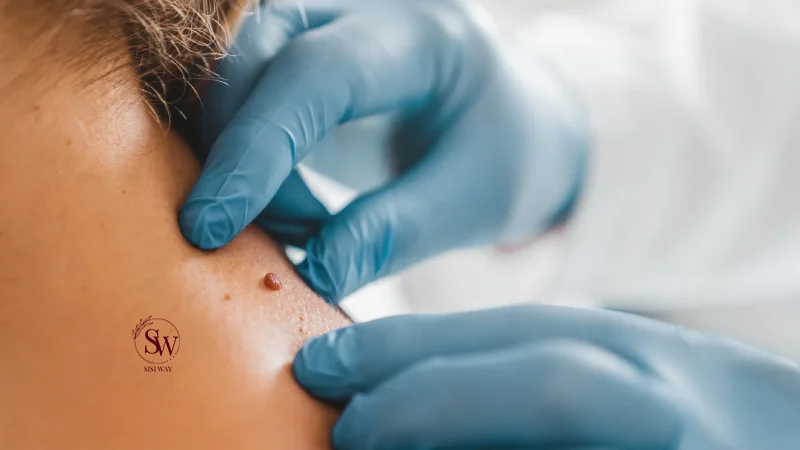
While skin tags are generally harmless, some individuals may opt for removal due to aesthetic reasons or discomfort. Common methods of removal include:
- Cryotherapy: This involves freezing the skin tag using liquid nitrogen, causing it to fall off after some time.
- Electrosurgery: Skin tags can be removed by cauterization using a high-frequency electrical current.
- Ligation: Tying off the blood supply to the skin tag using a thread or dental floss, causing it to wither and fall off.
- Excision: Surgical removal of the skin tag using a scalpel or scissors.
Preventive Measures
While complete prevention may not be guaranteed, certain measures can potentially reduce the likelihood of skin tag formation:
- Maintain a Healthy Weight: By managing weight, individuals can minimize skin folds and friction.
- Practice Good Hygiene: Keeping the skin clean and dry may help reduce the risk of skin tag development.
- Avoid Tight Clothing: Wearing loose-fitting clothing can decrease friction and irritation on the skin.
- Regular Skin Checks: Periodically inspect the skin for any new growths, allowing for early detection and intervention.
Is it OK to Remove Skin Tags?
The decision to remove skin tags is a personal one, influenced by a variety of factors, including aesthetic preferences, discomfort, and potential irritation caused by these benign growths. While skin tags are generally harmless, their removal is considered safe when performed by a qualified healthcare professional. Here are key considerations:
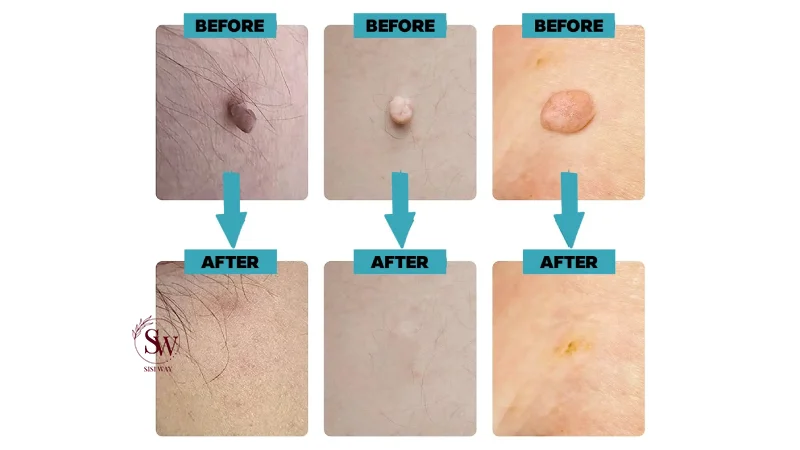
- Aesthetic Concerns: Many individuals choose to remove skin tags for aesthetic reasons. Skin tags, especially when located in visible areas, may cause self-consciousness or impact self-esteem. In such cases, removal can provide a cosmetic benefit, enhancing one’s overall appearance.
- Discomfort and Irritation: Skin tags can sometimes become irritated or uncomfortable, especially if they rub against clothing or jewelry. In these instances, removal can alleviate physical discomfort and prevent further irritation.
- Medical Consultation: It’s crucial to consult with a healthcare professional before deciding to remove skin tags. While various at-home remedies and over-the-counter products claim to facilitate removal, a medical assessment ensures a proper diagnosis and the identification of any underlying health conditions that may be contributing to skin tag development.
- Safe Removal Methods: Healthcare professionals employ safe and effective removal methods, such as cryotherapy (freezing), electrosurgery, ligation, or excision. These procedures are generally well-tolerated and carry minimal risk when performed by trained practitioners.
- Home Removal Risks: Attempting to remove skin tags at home may pose risks, including infection, scarring, or incomplete removal. Cutting or tearing skin tags without proper sterile conditions can lead to complications, emphasizing the importance of seeking professional guidance.
- Monitoring for Changes: It’s essential to monitor skin tags for any changes in size, color, or texture. If a skin tag exhibits unusual characteristics, such as bleeding, rapid growth, or irregular borders, prompt medical attention is advised to rule out other potential skin conditions.
Ultimately, the decision to remove skin tags should be a well-informed one, taking into account individual preferences, comfort, and overall well-being. Seeking the expertise of a healthcare professional ensures a safe and tailored approach to skin tag removal, minimizing the risk of complications and optimizing the outcome.
What Are the Side Effects of Skin Tag Removal?
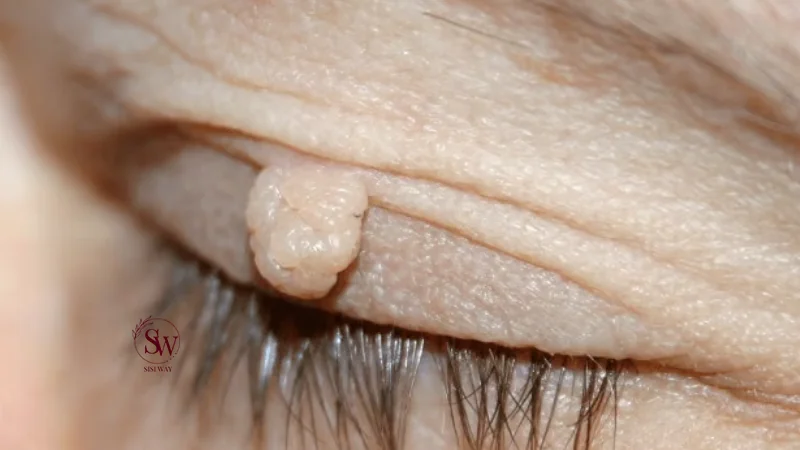
- Redness and Swelling: After skin tag removal, redness and mild swelling around the treated area are common and usually temporary. This is a natural response of the skin to the removal process.
- Pain or Discomfort: Some individuals may experience mild pain or discomfort after skin tag removal, particularly if the method involves cutting, freezing, or cauterization. Over-the-counter pain relievers or prescribed medications can help manage any discomfort.
- Bleeding: Minor bleeding is a potential side effect, especially if the removal method involves cutting the skin tag. Applying gentle pressure with a clean cloth or sterile dressing can usually control bleeding. If bleeding persists, seeking medical attention is advisable.
- Scarring: Depending on the removal method, scarring may occur. Surgical excision, for example, may leave a small scar. Healthcare professionals take measures to minimize scarring, but individual healing responses can vary.
- Infection: Any breach in the skin, whether from cutting, freezing or other removal methods, carries a risk of infection. Maintaining proper hygiene during the healing process is crucial to reduce this risk. Signs of infection include increased redness, swelling, pain, and the presence of pus.
- Incomplete Removal: In some cases, skin tag removal may be incomplete, leading to regrowth or the persistence of a portion of the tag. This can occur with certain at-home methods or if the removal process is not thorough.
- Allergic Reactions: Some individuals may be sensitive or allergic to certain ingredients in over-the-counter creams or solutions used for skin tag removal. It’s essential to be aware of any allergic reactions, such as itching, rash, or hives, and discontinue use if they occur.
- Changes in Pigmentation: Depending on the removal method and individual skin characteristics, there may be changes in pigmentation at the site of removal. This can result in lighter or darker areas of skin.
- Nerve Damage: Although rare, there is a potential risk of nerve damage during skin tag removal, particularly with certain surgical methods. This can lead to altered sensation in the treated area.
FAQs About Skin Tags
- Are skin tags cancerous?
No, skin tags are benign growths and are not associated with cancer. - Can I remove a skin tag at home?
The desire for a quick and convenient solution often leads individuals to explore at-home methods for removing skin tags. While various home remedies and over-the-counter products claim effectiveness, it’s essential to approach at-home removal with caution and awareness of potential risks. - Do skin tags grow back after removal?
In some cases, new skin tags may develop, but this is not guaranteed for everyone. - Are there any topical creams for skin tag removal?
Some over-the-counter creams claim to remove skin tags, but their effectiveness varies, and results may not be consistent.
Conclusion
Understanding skin tags involves unraveling the mysteries behind their formation, characteristics, and potential removal options. While often benign, these growths can impact individuals both physically and emotionally. By exploring the intricacies of skin tags, we empower ourselves with the knowledge to make informed decisions about their management and, if necessary, removal. Remember, consulting with a healthcare professional is always a prudent step for personalized guidance tailored to individual circumstances.



